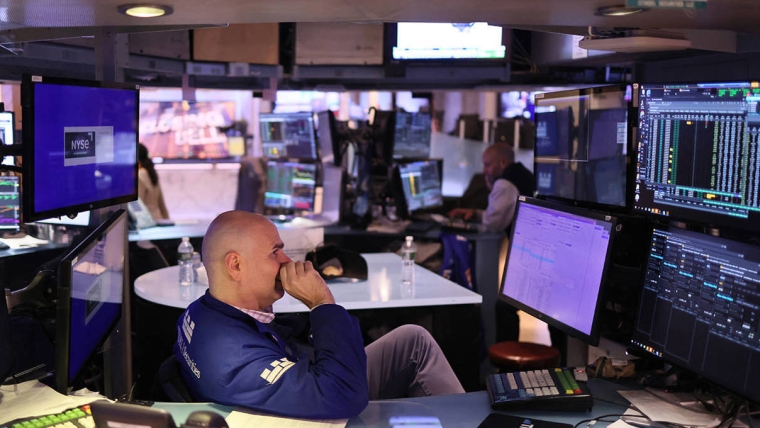
Behavioral economists have popularised the term “recency bias” to describe our tendency to be disproportionately influenced by the latest events compared to earlier ones. Could this cognitive phenomenon explain why numerous analysts have a rather optimistic tilt for the world economy in 2024? Or are there really positive trends counterbalancing the obvious and mounting challenges to global growth?
A recent Financial Times editorial reflected the prevailing optimism, proclaiming that “after this year’s resilient showing, there is every chance that the reality next year will also be better than expected.” The trends that supported the global economy’s unexpected resilience in 2023 “also offer plenty of reasons to be optimistic for 2024.”
This upbeat mood has spread to financial markets. A growing number of commentators have predicted that stock markets will finish the year above the already elevated levels of 2023, which were buoyed by a remarkable year-end rally.
Today’s optimistic sentiment stands in stark contrast to the grim predictions that dominated the run-up to 2023, when Bloomberg Economics asserted that there was a 100% probability that the United States would fall into a recession. It is also at odds with a range of economic, financial, geopolitical, and political developments. Notably, it appears to be predominantly driven by a single factor: central banks aggressively cutting interest rates amid the softest of all soft landings for the US economy.
To be sure, central banks have enormous sway over financial-market sentiment. Since the 2008 global financial crisis, central bankers have acted as the world’s leading policymakers – flooring interest rates, flooding economies with liquidity, fueling huge gains across virtually all asset classes, and facilitating a notable shift in wealth distribution that overwhelmingly benefited the wealthiest. But this trend reversed in 2022 when central banks, led by the US Federal Reserve, belatedly responded to rising inflation by embarking on one of the most aggressive cycles of interest-rate hikes ever. The subsequent losses in both high-risk and low-risk assets seemed poised to continue into 2023 until the consensus forecast shifted toward significant rate cuts and renewed talk of a “Fed put.”
While central banks have had a significant effect on market confidence, their impact on actual economic outcomes has been limited. Their ultra-dovish policies during the 2010s helped keep the global economy afloat, yet overall growth remained disappointingly low, unequal, and still detached from climate realities. The 2022 shift to tighter monetary policies was expected to lead to higher unemployment and sluggish growth; instead, the US unemployment rate ended 2023 at a remarkably low 3.7%, and third-quarter annualised growth accelerated to 4.9%. Moreover, the extent to which aggressive interest-rate hikes contributed to reducing inflation has become the subject of debate among economists.
These developments suggest that central-bank policies alone – investors currently expect the Fed to cut interest rates by around 1.5 percentage points – may not be enough to generate the necessary growth momentum to withstand the headwinds facing the global economy.
In fact, one would be hard-pressed to find a systemically significant economy poised for breakout growth in 2024. As China remains saddled with an economic model that yields diminishing returns, the authorities have acknowledged that its growth rate is constrained by domestic inefficiencies, pockets of excessive debt, increased global fragmentation, and the West’s weaponisation of trade and investment. Europe, for its part, is unlikely to replicate last year’s unexpectedly strong performance, given especially the sluggishness of global manufacturing and Germany’s economic stagnation.
Once again, commentators seem to be placing their hopes on US economic exceptionalism. But things have evolved over the past year. Lower pandemic-era household savings and higher debt act as headwinds to America’s remarkably agile and resilient economy. Moreover, recent interest rate increases are likely to continue to constrain new household mortgages, companies navigating the mountain of corporate debt expected to mature in 2025, and highly leveraged non-bank institutions dealing with their losses.
The current geopolitical climate also is not conducive to robust growth. The devastating aftermath of Hamas’s brutal October 7 attack against Israel, in which Israel has destroyed much of Gaza and is reported to have killed more than 23,000 Palestinians – mostly civilians, including thousands of women and children – has challenged hopes of containing the crisis. Israel and the Iran-backed Lebanese militia Hezbollah appear headed toward greater hostilities, and attacks against commercial vessels in the Red Sea by the Yemeni Houthis are already disrupting global trade in a manner that renews stagflationary pressures on the global economy.
Beyond the Middle East, Western democracies and many developing countries face important elections in 2024.
Given these circumstances, the chances of robust global growth in 2024 appear tenuous. Nevertheless, there are two ways to mitigate the threats posed by an increasingly fragile economic and geopolitical environment. First, policymakers need to launch major economic-policy overhauls, focusing on structural reforms aimed at cultivating the growth and productivity engines of tomorrow. Second, the international community needs to do better to end the atrocities in the Middle East before that conflict spreads even further across the region and fuels geopolitical turmoil beyond it. Without these interventions, today’s optimists will be sorely disappointed by year’s end.
Mohamed A. El-Erian, President of Queens’ College at the University of Cambridge, is a professor at the Wharton School of the University of Pennsylvania and the author of The Only Game in Town: Central Banks, Instability, and Avoiding the Next Collapse (Random House, 2016). Copyright: Project Syndicate, 2024, published here with permission.
17 Comments
Good to see a counter argument to the prevailing “she’ll be right” narrative. Global debt restructuring led by the US will have a big say in the next couple of years. Strap yourselves in we are in for a wild ride. A lot of pin to come but hopefully our kids can afford a house and a life by the end of it.
"when Bloomberg Economics asserted that there was a 100% probability that the United States would fall into a recession" - there was no “she’ll be right” narrative at the start of 2023, yet the US was alright. Surely we go into this year in a much better shape than last year, so we should expect a better outcome than last year.
🤣
Good to see a roll-over of debt mentioned in 2025. That's a worry as much of it was re-financed at very low rates during covid.
DGM!
I agree
Said it a few times, the next 12 months from June, if not sooner, will prove to be a good time to be an asset buyer, because most people will not be asset buyers. Whatever your choice of asset may be.
Its only a good time if you get the asset at a good price isn't it? Are you are expecting assets to go down in price over the next 12 months from June?
I'm expecting the cost to borrow to go down, cost of asset to be flat, pent demand to build but not reflect in price.
focusing on structural reforms aimed at cultivating the growth and productivity engines of tomorrow
For NZ that just means pile more money towards the same old houses, right? We don't have enough glorified RE agents on billboards welcoming people to the country.
I can't see the growth necessary for another housing boom, and if we attempt one, we'll be third world by 2040.
It wont be long before our greatest export is young working folk.
For now though, young working folk are our biggest imports !
You mean like all the ELE worker immigrants now sleeping in their cars?
I'm expecting that within a year our birth rate will be below 1.5 per woman. National with their head in the sand won't understand why as everyone they know has helped their kids buy houses and everyone is happy.
Then they will say that if people don't "want" to have kids then we need more immigrants... (facepalm)
IMO, El Erian is one of the few balanced, open-minded and very intelligent economists. I believe he's spot on.
Agree. So long as there is a reasonable case for economic weakness, as he sets out, and while interest rates are pretty high, I am happy to keep my Kiwisaver in a cash account.
I am starting to look at a handful of share options however. A couple in particular really interest me
What? No mention of the fact that the mega-wealthy are sitting on massive stockpiles of unproductive assets?
Simple answer to that one.
Tax the mega-rich b'stards hard and redistribute the wealth into the hands of the leaner and hungrier.
'Growth' - if that's what is wanted - is assured.
Plodding along using as little fossil fuels as possible works fine for me. Growth? Vastly overrated IMNSHO unless it's Green Growth.

We welcome your comments below. If you are not already registered, please register to comment.
Remember we welcome robust, respectful and insightful debate. We don't welcome abusive or defamatory comments and will de-register those repeatedly making such comments. Our current comment policy is here.